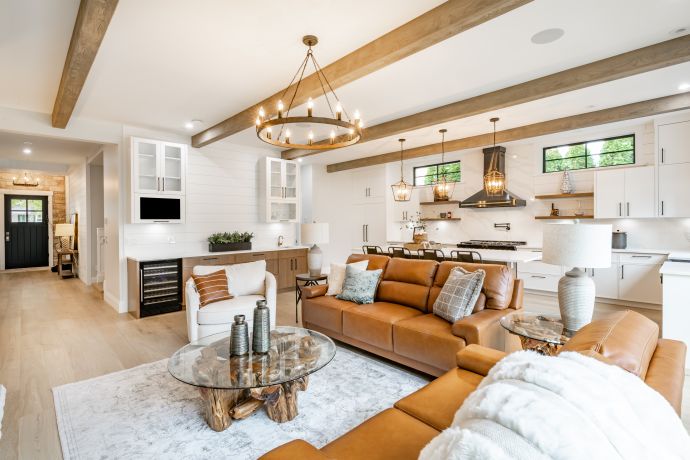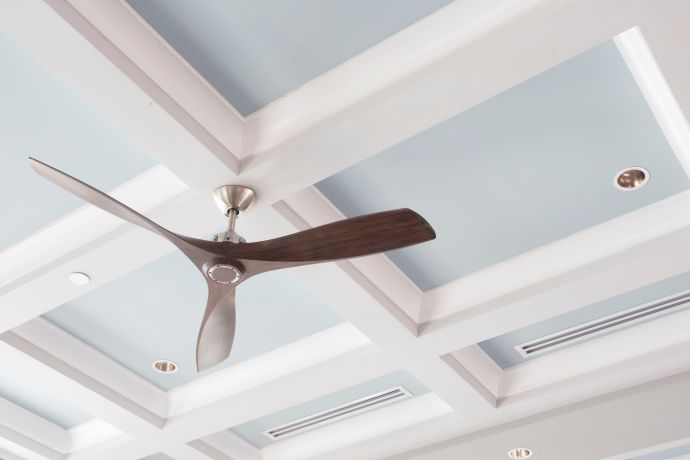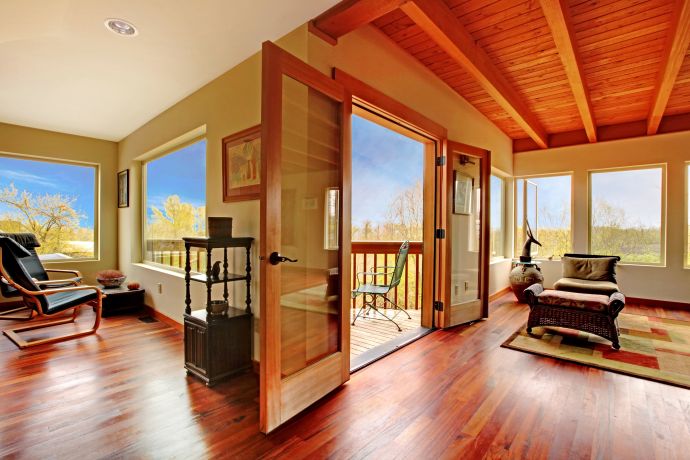July 23, 2025
Ceilings are usually the last thing people think about when designing their home. But they take up just as much space as the floor, and when used well, they can completely shift how a room feels. A custom ceiling can make a small room feel taller, add softness to an open space, or highlight architectural features in a subtle, elegant way.
At Joseph A. Interiors, we design ceilings that work in harmony with the rest of your space. When every surface is considered, the whole home feels more intentional. Read on to learn how custom ceiling design can elevate your home in ways you might not expect.
Why Ceiling Design Matters

Ceilings should be far from an afterthought and are often the perfect blend of form and function.
Think of your ceiling as the fifth wall of a room. It shapes how the entire space feels, whether cozy and grounded or expansive and dramatic. Architectural ceiling treatments can bring a sense of craftsmanship, create visual balance, and help delineate open floor plans. In spaces like dining rooms, foyers, and primary suites, a well-designed ceiling can anchor the room and turn an ordinary space into a showcase.
Beyond aesthetics, ceiling design also has functional benefits. Strategic millwork can help conceal structural beams, ductwork, or wiring, while also improving acoustics and adding insulation. With the right design, a ceiling can elevate both the look and performance of your home.
Types of Custom Ceiling Treatments

There are several ways to bring personality and polish to your ceilings. The best choice depends on your home’s style, architecture, and goals for the space.
Coffered Ceilings
Coffered ceilings feature a grid of recessed panels, typically framed by wood beams. They add richness and structure to a room, drawing the eye upward and adding visual interest. This style has classical roots but can be adapted for traditional, transitional, or even modern interiors, depending on the profile and scale of the moldings.
Coffered ceilings are especially popular in large living areas, dining rooms, and home offices. They offer a timeless elegance and provide an excellent opportunity to highlight lighting fixtures or painted contrasts within each panel.
Exposed and Faux Beams
Beams bring a sense of warmth and architectural drama. In older homes, you may already have structural beams that can be restored or enhanced with millwork. In newer construction, faux beams can achieve the same visual impact without the weight or engineering challenges.
Beams can run parallel, intersect, or radiate in creative layouts, depending on the shape of the ceiling. They’re often seen in great rooms, kitchens, and vaulted spaces. Materials range from rustic reclaimed wood to clean, painted finishes that suit more refined styles.
Tray and Vaulted Ceilings
Tray ceilings feature a raised central section, often with step-like transitions or layered moldings. This design works well in rooms with higher ceilings, adding subtle drama without overpowering the space. Recessed lighting or soft uplighting can be tucked into the tray for a cozy, ambient glow.
Vaulted ceilings follow the roofline and create a sense of airiness and grandeur. These are ideal in spaces that aim to feel open and expansive. Adding exposed beams or tongue-and-groove paneling along the vault keeps the room feeling warm instead of cavernous.
Matching Ceiling Styles to Your Interior

The key to a successful ceiling treatment is cohesion. Every element, from material selection to pattern and proportion, should support the overall design of your home. A highly detailed coffered ceiling might feel out of place in a modern minimalist home. Sleek beams or flat paneling can feel too sparse in a traditional space.
We often start by looking at the architecture and finishes already present. Flooring, cabinetry, built-ins, and trim all provide cues for how to carry that same level of detail overhead.
We also consider ceiling height, natural light, and what type of mood you want to create. A lower ceiling can benefit from lighter tones and simpler profiles, while taller ceilings allow more room to layer in complexity.
Paint, stain, or even wallpaper can play a role, especially inside recessed areas. Ceiling treatments should complement the room’s lighting plan as well. Integrated LED strips, pendants, or chandeliers can all be used to accentuate the architecture above.
How Joseph A. Interiors Crafts Custom Ceilings
At Joseph A. Interiors, ceiling design is never an afterthought. Every project begins with detailed measurements and a clear understanding of your goals. We draw from decades of experience in custom millwork to propose solutions that feel intentional and tailored to your space.
Our process includes 3D modeling, hand-selected materials, and expert craftsmanship from fabrication to installation. From the first sketch to the final nail, we take pride in helping clients transform the ceilings above them into works of art.
Transform Your Home with Joseph A. Interiors: Contact Us for Customized, Expert Interior Solutions



